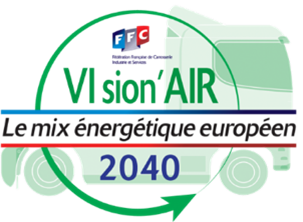
35 to 40% of new heavy goods vehicles sold in Europe in 2030 would be Zero Emission, according to a VIsion'AIR analysis note presented today. A share incommensurate with the current 2% and yet much lower than the announcements of most Manufacturers.

An alternative vision, nevertheless making it possible to meet the CO 2 objectives
The Vision'Air study, carried out by the FFC in partnership with BDO Advisory, and its 35 to 40% of new "zero-emission" heavy goods vehicles in Europe in 2030, offers an alternative vision to that of most manufacturers, which have 50% targets. A more diversified engine mix would, however, be enough to achieve the objective, voted by the European Commission on April 10, of reducing CO 2 emissions from new heavy goods vehicles by 45%.
A vision conditioned on significant price reductions
Achieving 35% of new zero-emission heavy goods vehicles in Europe in 2030 represents a very significant acceleration compared to today's 2%.
This requires an ambitious context between now and 2030, reflecting the commitment of all players in the sector:
TCOs not yet competitive in 2030 in long distance and hydrogen
Even if all these conditions are met, certain TCOs will not be competitive compared to other engines: in particular those of Hydrogen heavy goods vehicles and those of electric heavy goods vehicles for long distance uses. A focus on the evolution of Tractor TCO provides an example.
The growth of zero-emission heavy goods vehicles will therefore be significant in Europe by 2030, but hampered by TCOs that are still non-competitive for certain uses or technologies and conditional on sufficient energy infrastructure.
Independence of vision
The results are based on hypotheses constructed with the help of a consortium of players in the sector: manufacturers, equipment manufacturers, energy companies and transporters.
The independence of VIsion'AIR results is due to the model developed by BDO Advisory. This model simulates rational choices of demand based on cost, purchasing and usage (TCO) criteria, depending on the engines available, the categories of heavy goods vehicles and the distances to be covered.
A sector today in uncertainty according to Patrick Cholton
Charging networks for electric heavy goods vehicles or refueling networks for hydrogen heavy goods vehicles are not sufficiently developed and are very expensive. Zero-emission heavy goods vehicles have a high initial cost which is a barrier for many fleet operators.
Battery autonomy for electric heavy goods vehicles appears insufficient for long distances, requiring frequent stops. In addition, these heavy goods vehicles may have a reduced payload capacity due to the weight of the batteries, which makes them less competitive.
Government policies may lack clarity or stability depending on the country, discouraging investment in zero-emission heavy goods vehicles. Financial incentives, whether subsidies or tax credits, are insufficient to offset the high initial costs.
Declaration: This article comes from the FFC.If copyright issues are involved, please contact us to delete.